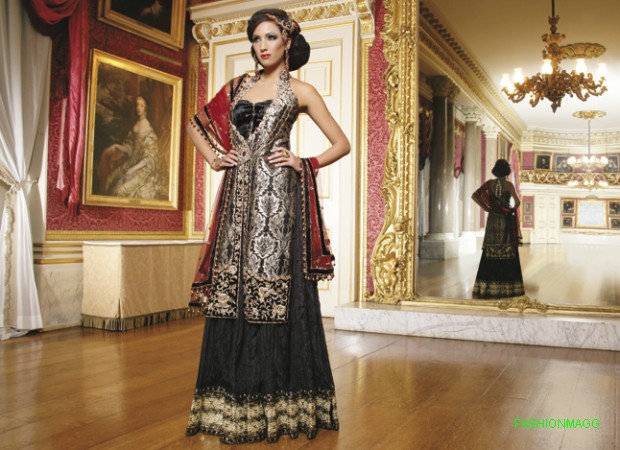Pakistani Wedding Dress Dresses Suits Mehndi Designs Pic Jewellery Mehndi Lehengas 2013
Source: google.com.pk
Wedding Dress History
In the nineteenth century, even a bride who wore white would expect to wear her dress again. For the season of her "bride visits" when she would do the rounds of family, friends and acquaintances as a newly married woman, she would wear her bridal gown, with the train and flowers removed. A higher class bride would then adapt the bodice of the outfit (which was often made separately) and retrim it for evening wear for another season. Queen Victoria herself removed the lace overskirt from her dress and frequently used it again - she wore it over a black silk gown for her Diamond Jubilee celebrations over 50 years later.
The 1940s
The white wedding dress virtually disappeared during the war years. Clothes rationing was introduced in 1941, when fashion almost ceased to exist. A few made brave efforts with parachute silk, whilst others wore gowns borrowed from relatives, but most brides wore uniform. Those not in the services also tended to wear a suit, or "costume" as they were called then, with a floral corsage pinned to the lapel. Betty Hutton, the Woolworth heiress (right) chose a blue silk costume with matching veiled hat for her wedding to Cary Grant in 1942. After the war ended, rationing was still in force, but nobody wanted Princess Elizabeth to skimp on her wedding gown - clothing coupons poured into Buckingham Palace in 1947 from loyal citizens wanting to see her at her best at her marriage to Philip Mountbatten in Westminster Abbey. Consequently, her Hartnell gown was sumptuous, with embroidery and beading decorating the flowing satin, with its long train and silk net veil. The sweetheart neckline and wide shoulders followed a predominant style of the decade, which was soon to give way, in the late forties, to Dior's stunning New Look, with narrow shoulders, nipped waist and wide skirts.
The 1950s
When Joyce Holmes (right) married Gerald Locking in 1951, her gown showed an intermediate style between the padded shouders of the forties, and the narrow look of the fifties. Her draped skirt, reminiscent of Princess Elizabeth's, extended into a full train. The fabric was a creamy satin, with no trimming at all. By contrast in 1955, her cousin Jill Wringe (left), at her wedding to Victor Savage, wore a totally New Look outfit. Her dress was like many others of the decade, of "ballerina" length, and made with a removable lace jacket bodice with the ubiquitous tight sleeve with cuff pointed over the hand, worn over the low cut underdress with its circular skirt held out by stiff petticoats. Many women wore variations on this look, and had the under-dress dyed a new colour afterwards to wear as a cocktail dress. Brocade and lace gradually superceded satin almost universally for wedding gowns. To counterbalance the bouffant skirts, veils, which had previously been usually square, worn folded diagonally with the point at the back and sides, now became circular and waist-length, usually attached to a coronet style headdress.
The 1960s
The early sixties showed little change on the bridal front. Girls still wore circular skirts, sometimes supported by crinolines, tight sleeves and short veils. The only real change was that the veils became more bouffant, to match the back-combed hairstyles then in vogue. A popular alternative to the coronet was a large single rose, worn high on the forehead, to which the veil was gathered. In contrast, bouquets shrank, and tight little posies were prefered over the large, loose bouquets previously carried. Commentators professed to be surprised by the lack of embroidery or ornamentation on Princess Margaret's wedding dress (right) in 1960, but it was quintessentially of its era. The only difference was that hers lengthened into a train at the back, with a matching long veil. By the middle years of the decade, however, the influence of the "Swinging Sixties" designs of Mary Quant and co were beginning to alter even the bridal profile, and waistlines first dropped, as worn by Eileen Bessant to her wedding in 1965 to Steven Bessant (left) and then straight, shift-style dresses began to be seen, like that of Eileen's cousin Christine Holmes, who married Paul Heron the same year. Along with the narrower line, returned the train and the "cathedral" veil, so named because only brides married in cathedrals had previosly worn them! The shift soon proved too shapeless for wedding fashion, and it quickly evolved into the empire line, with the waist tight under the bust. Influenced by mainstream design, some girls abandoned veils in favour of floral bonnets, or floppy hats. This development continued into the next decade, when hoods attached to the dress, and Juliet caps worn with or without a veil, also became popular headgear.










No comments:
Post a Comment